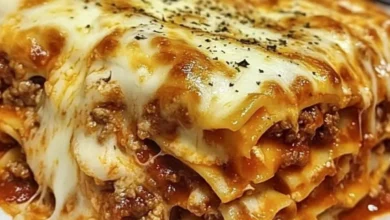Unveiling Osso Buco: A Culinary Journey into Italy’s Most Beloved Braise

More Than Just a Meal
In the world of comfort food, few dishes command the reverence of Osso Buco. Hailing from the culinary heartland of Lombardy, Italy, this Milanese masterpiece is not merely a recipe; it is an experience. The name itself, “Osso Buco,” translates to “bone with a hole,” a humble description for a dish of profound depth and elegance. It is a celebration of patience, technique, and the transformative power of slow cooking. This guide will walk you through everything you need to know to create an unforgettable Osso Buco in your own kitchen a dish that promises to transport your senses straight to a rustic Italian trattoria.
The Soul of the Dish: Understanding the Components
Before we fire up the stove, it’s crucial to understand the key players in this culinary symphony. Each component has a specific role, and their harmony is what creates the magic.
1. The Star: Veal Shanks (Ossobuco)
The non-negotiable foundation of authentic Osso Buco is cross-cut veal shanks. These are sections of the hind shank, each containing a piece of marrow-filled leg bone in the center. When selecting your shanks:
- Thickness: Aim for pieces about 1.5 to 2 inches (3-5 cm) thick. This ensures the meat cooks evenly without drying out.
- Marrow: The marrow is a delicacy. Ensure the bone hole is clear and filled with this rich, buttery substance.
- Tying: Butchers often tie the shanks with kitchen twine. This is essential to keep the meat attached to the bone during the long braising process.
2. The Aromatic Base: Soffritto
The soul of the sauce is the soffritto, the Italian version of mirepoix. This holy trinity consists of:
- Onion: Finely diced, providing a sweet foundation.
- Carrot: Finely diced, adding a subtle earthy sweetness.
- Celery: Finely diced, contributing a necessary herbaceous note.
The key is to dice these vegetables very finely so they melt into the sauce, creating a velvety texture.
3. The Flavor Builders: Liquid and Aromatics
- Wine: A dry white wine like Pinot Grigio or Sauvignon Blanc is traditional for the Milanese version. It deglazes the pan, lifting the browned bits of meat and vegetables, and adds a bright acidity that balances the richness. Some modern variations use red wine for a deeper flavor.
- Broth: High-quality beef or chicken broth forms the bulk of the braising liquid. Use a low-sodium version to control the salt level.
- Tomato: While purists might use only a tablespoon of tomato paste, many recipes include canned crushed tomatoes or passata for a richer, more robust sauce.
- Herbs: A bay leaf and a few sprigs of fresh thyme are classic. They are added to the pot to infuse their fragrance slowly.
4. The Finishing Touch: Gremolata
Often mistaken as a mere garnish, Gremolata is the vibrant, zesty counterpoint that lifts the entire dish. It’s a simple mixture of:
- Freshly chopped flat-leaf parsley
- Finely minced garlic
- The zest of a lemon
This bright, fresh condiment is sprinkled over the rich, slow-cooked veal just before serving, cutting through the fat and awakening all the flavors.
The Art of Patience: How to Cook the Perfect Osso Buco
This is not a rushed weeknight meal. Osso Buco is a lesson in patience, where low heat and time are your most valuable ingredients.
Prep Time: 30 minutes
Cook Time: 2 to 2.5 hours
Serves: 4-6
Ingredients:
- 4-6 cross-cut veal shanks (about 1.5 inches thick), tied
- Salt and freshly ground black pepper
- All-purpose flour, for dredging
- 3 tablespoons olive oil
- 3 tablespoons unsalted butter
- 1 medium onion, finely diced
- 1 large carrot, finely diced
- 1 large celery stalk, finely diced
- 3 cloves garlic, minced
- 1 cup dry white wine
- 2 tablespoons tomato paste
- 1 (14-oz) can crushed tomatoes (or 1.5 cups passata)
- 2 cups low-sodium beef or chicken broth
- 1 bay leaf
- 2 sprigs fresh thyme
For the Gremolata:
- 1/2 cup fresh flat-leaf parsley, finely chopped
- 2 cloves garlic, very finely minced
- Zest of 1 large lemon
Cooking Method:
Step 1: Prepare and Sear the Shanks
Pat the veal shanks completely dry with paper towels. This is critical for achieving a good sear. Generously season both sides with salt and pepper. Dredge each shank in flour, shaking off any excess.
In a large, heavy-bottomed Dutch oven or a wide braising pan, heat the olive oil and butter over medium-high heat. Once hot, add the shanks in a single layer, working in batches if necessary to avoid overcrowding. Sear for 4-5 minutes per side until a deep, golden-brown crust forms. Remove the shanks and set them aside on a plate.
Step 2: Build the Soffritto and Foundation
Reduce the heat to medium. Add the diced onion, carrot, and celery to the same pot. Sauté for 6-8 minutes, stirring occasionally, until the vegetables have softened and started to take on a light golden color. Add the minced garlic and cook for another minute until fragrant.
Step 3: Deglaze and Develop Flavor
Stir in the tomato paste and cook for one minute to caramelize it slightly. Pour in the white wine, using a wooden spoon to scrape all the browned bits (the fond) from the bottom of the pot. Let the wine simmer and reduce by half, about 3-4 minutes.
Step 4: The Braise
Add the crushed tomatoes and broth to the pot. Stir to combine. Return the seared veal shanks to the pot, along with any accumulated juices. They should be nestled in a single layer and mostly submerged in the liquid. Add the bay leaf and thyme sprigs.
Bring the liquid to a gentle simmer. Then, cover the pot with a tight-fitting lid and reduce the heat to the lowest possible setting. Let it braise slowly for 1.5 to 2 hours. The dish is ready when the meat is incredibly tender and is just starting to pull away from the bone.
Step 5: Final Touches and Serving
While the Osso Buco is braising, prepare the gremolata by simply combining the parsley, minced garlic, and lemon zest in a small bowl.
Once the veal is done, carefully transfer the shanks to a warm serving platter. If the sauce seems too thin, you can increase the heat and let it simmer uncovered for 5-10 minutes to thicken. Taste and adjust seasoning with salt and pepper.
Step 6: The Grand Finale
Place a veal shank in the center of each shallow bowl. Spoon the rich, aromatic sauce over the top. Finally, and most importantly, garnish generously with the fresh gremolata.
Serving Suggestions & The Marrow Ritual
The traditional and sublime pairing for Osso Buco is Risotto alla Milanese—a creamy saffron risotto. The luxurious risotto is the perfect canvas for the rich sauce. Creamy polenta or mashed potatoes are also excellent alternatives.
Do not forget the marrow! This is the “hole” in the “bone.” Encourage your guests to scoop out the soft, buttery marrow from the bone center with a small spoon. It is a rich, decadent treat, often spread on a piece of crusty bread the true chef’s reward.
Conclusion: A Dish Worth the Wait
Osso Buco is more than the sum of its parts. It is a testament to the beauty of slow food a process that cannot be hurried. From the initial sizzle of the sear to the final sprinkle of zesty gremolata, creating this dish is a labor of love. The result, however, is unforgettable: meat that dissolves at the touch of a fork, a sauce of profound complexity, and an aroma that will fill your home with the warmth of Italy. So, take your time, savor the process, and buon appetito!



